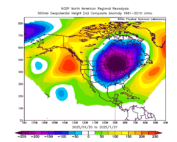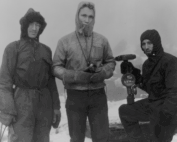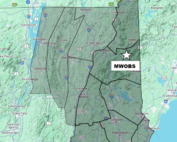Five Common Aurora Questions We Receive
2013-10-09 23:46:06.000 – Ryan Knapp, Weather Observer/Meteorologist
Aurora from October Second.
If you are an avid follower or frequent checker of our Facebook page, you may have viewed a few of our Aurora Borealis (or Northern Lights) images over the past year or so (on a side note, you do not need a Facebook username or password to view our content; you only need one if you intend to ‘Like’ or leave comments on any content). While we like to share these images, they always generate a ton of questions. So, I will answer five of our most common questions.
1. When are they coming? The Mount Washington Observatory is a weather station. We do not measure or forecast Aurora Borealis or any other space related activity. None of us are remotely certified or degreed to do so either. The only way we know activity is going to occur is by monitoring sites like NOAA POES Auroral Activity Map, solarham.com, or spaceweather.gov or several other sites available with a simple Google search. While websites help us keep an eye out for them, most of the time, we are caught off guard when they occur just as much as any other untrained person in the region.
2. Can you notify us when they are happening or going to occur? Unfortunately, since none of us know how to forecast these events, the best we can do is point you to the websites mentioned above. Additionally, if you have a smartphone, there are several ‘apps’ available that can assist you in receiving notifications. And if you happen to have a Facebook or Twitter account, there are several ‘space weather’ related sites that can keep you well informed. The best we can do is post information to our Facebook page as we observer them.
3. When is the best time to see them? They are best viewed when it is dark and the darker the better. So get away from city lights or any light source in general. While they can be seen with a full moon, the less moonlight there is the better. Winter tends to have better viewing opportunities however, they can be seen during any month of the year at our latitude. And they occur more often during years of solar maximum (which we are currently in apparently).
4. Where is the best place to view them? Mountain tops help as they give you a further viewing horizon. But, anywhere you have a long stretch to the north can work too. So a large field or really long north to south stretching lake can be great places to view them in our experiences. And the further north you are, the better your chances. And while it should go without saying, the Northern Lights in our hemisphere are typically only seen to the north (they would have to be really, really strong for us to see anything to the south of our location).
5. Are they as vivid as they look in pictures? Sometimes and to some individuals. Some people I have been out shooting with can see the full spectrum while others only see select colors. So don’t be disappointed if they don’t look exactly like they do in the pictures you have seen.
I hope some of these tips help you in possibly viewing them and we will continue to share them when we can view them.
Ryan Knapp, Weather Observer/Meteorologist
Going with the Flow: Why New England Didn’t Experience Any Classic Nor’easters This Winter
Going with the Flow: Why New England Didn’t Experience Any Classic Nor’easters This Winter By Peter Edwards Why didn’t the Northeast experience any major snowstorms this year? If I had to guess, it’s the
A Look at The Big Wind and Measuring Extreme Winds At Mount Washington
A Look at The Big Wind and Measuring Extreme Winds at Mount Washington By Alexis George Ninety-one years ago on April 12th, Mount Washington Observatory recorded a world-record wind speed of 231 mph. While
MWOBS Weather Forecasts Expand Beyond the Higher Summits
MWOBS Weather Forecasts Expand Beyond the Higher Summits By Alex Branton One of the most utilized products provided by Mount Washington Observatory is the Higher Summits Forecast. This 48-hour forecast is written by MWOBS






